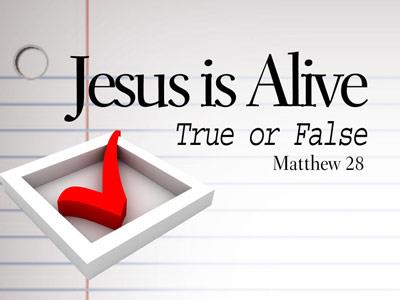-
Seeing Is Believing (Part One)
Contributed by Derrick Tuper on Apr 20, 2020 (message contributor)
Summary: This is part one of a two part series on the resurrection appearances to Mary and the disciples.
SEEING IS BELIEVING (part one)
In September, 1938, a man who lived on Long Island ordered an expensive barometer. When it arrived he was extremely disappointed to find that the dial was stuck; it pointed to “Hurricane.” This can't be right; hurricanes don't happen around here. After shaking the barometer vigorously several times, the man concluded that he had a defective product. "I spent good money on this piece of junk."
He sat down and wrote a scathing letter to the store from which he had purchased the instrument. He mailed it the following morning on his way to his office in New York. That evening he returned to Long Island to find the barometer missing–along with his house! The barometer had been right. This man didn't believe the barometer was correct until he saw the proof with his own eyes.
Jesus' disciples weren't convinced that he had come back to life until they saw him with their own eyes.
1) “Where’s Jesus?”
John 20:1-9, "Early on the first day of the week, while it was still dark, Mary Magdalene went to the tomb and saw that the stone had been removed from the entrance. So she came running to Simon Peter and the other disciple, the one Jesus loved, and said, “They have taken the Lord out of the tomb, and we don’t know where they have put him!”
So Peter and the other disciple started for the tomb. Both were running, but the other disciple outran Peter and reached the tomb first. He bent over and looked in at the strips of linen lying there but did not go in. Then Simon Peter, who was behind him, arrived and went into the tomb.
He saw the strips of linen lying there, as well as the burial cloth that had been around Jesus’ head. The cloth was folded up by itself, separate from the linen. Finally the other disciple, who had reached the tomb first, also went inside. He saw and believed. (They still did not understand from Scripture that Jesus had to rise from the dead.)"
Last week in the Sunday school I asked what evidences could we tell people about that showed that Jesus rose from the dead. We have another one here with the stone. It's understood that a deep groove would be dug out and the very large and heavy stone was placed into it and rolled down into place.
Being that there would be an incline on either side, the disciples would need to roll this stone up the incline and out of the groove, while staying undetected by the guards. This would be nearly impossible to pull off; thus making the idea that the disciples came and stole the body ludicrous.
The reason Mary is going to the tomb is so she can anoint Jesus. In other gospel accounts Mary is joined by Mary the mother of James and Salome. John mentions only Mary because she is the central figure.
So Mary gets to the tomb, sees the stone is already rolled away and assumes someone came and removed Jesus' body. So she runs to tell the disciples. She sees Peter and John and tells them. Peter and John race to the tomb. John was a faster runner and gets there first but hesitated in going in. Peter gets there and moves past John and goes in.
Both Peter and John recognize the linens are there. This should’ve helped them to believe that the body wasn’t taken away for who would unwrap it and neatly fold the linen before removing the body? Then, John goes all the way in and sees how everything was. It says he saw and believed. But based on vs. 9 all he believed was what Mary had told him-that Jesus wasn't there.
So this is the first instance of seeing was believing for them. Luke 24:12 says that Peter went away wondering what had happened. They believed that the body was missing, but at this point, they were not yet ready to believe that Jesus had risen from the dead. They needed more proof.
They shouldn't have since Jesus had told them he was going to come back to life. But with the empty tomb the evidence is there for them to edge closer to the point of fully believing in the resurrected Christ.
Many people are gradual believers. Some things about Christ are easier for them to accept than others. As they go along they become more convinced. They see or hear something that causes them to wonder, like Peter. Then, like John, they believe to an extent. As time goes on, if they remain open, the Lord will show himself to them in a way that leaves no doubt and they become fully convinced.

 Sermon Central
Sermon Central



